Chris Eboch's Blog, page 7
December 2, 2020
#Holiday Gift Guide – Great Books (historical fiction, fantasy, and contemporary fiction) for Middle Grade Readers #Christmas #KidLit
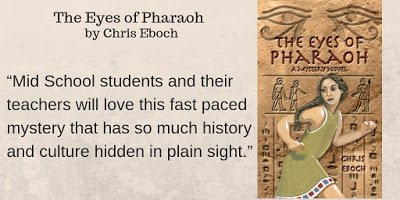 If you have a young reader on your shopping list, consider one of these titles, appropriate for ages 8 to 15.
If you have a young reader on your shopping list, consider one of these titles, appropriate for ages 8 to 15. Middle Grade Novels with History The Eyes of Pharaoh Ancient Egypt in 1177 BC comes to life. When Reya hints that Egypt is in danger from foreign nomads, Seshta and Horus don’t take him seriously. How could anyone challenge Egypt? Then Reya disappears. To save their friend, Seshta and Horus spy on merchants, soldiers, and royalty, and start to suspect even The Eyes of Pharaoh, the powerful head of the secret police. Will Seshta and Horus escape the traps set for them, rescue Reya, and stop the plot against Egypt in time? See this and more at www.chriseboch.com or her Amazon page. Usually $4.99 for the ebook but only 99 cents this month! (Also available in paperback.)
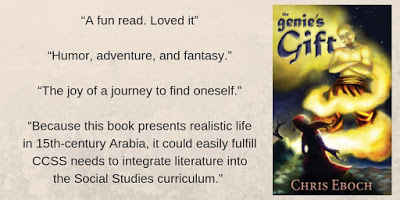 The Genie’s Gift
This lighthearted action novel set in the fifteenth-century Middle East draws on the mythology of The Arabian Nights. Shy and timid Anise determines to find the Genie Shakayak and claim the Gift of Sweet Speech. But the way is barred by a series of challenges, both ordinary and magical. How will Anise get past a vicious she-ghoul, a sorceress who turns people to stone, and mysterious sea monsters, when she can’t even speak in front of strangers? The ebook is just $2.99 this month! (Also available in paperback.)
The Genie’s Gift
This lighthearted action novel set in the fifteenth-century Middle East draws on the mythology of The Arabian Nights. Shy and timid Anise determines to find the Genie Shakayak and claim the Gift of Sweet Speech. But the way is barred by a series of challenges, both ordinary and magical. How will Anise get past a vicious she-ghoul, a sorceress who turns people to stone, and mysterious sea monsters, when she can’t even speak in front of strangers? The ebook is just $2.99 this month! (Also available in paperback.)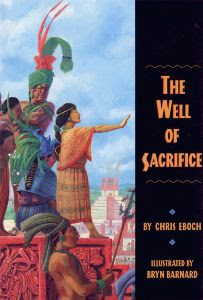 The Well of Sacrifice A Mayan girl in ninth-century Guatemala rebels against the High Priest who sacrifices anyone challenging his power.
The Well of Sacrifice A Mayan girl in ninth-century Guatemala rebels against the High Priest who sacrifices anyone challenging his power. Kirkus Reviews called The Well of Sacrifice, “[An] engrossing first novel….Eboch crafts an exciting narrative with a richly textured depiction of ancient Mayan society….The novel shines not only for a faithful recreation of an unfamiliar, ancient world, but also for the introduction of a brave, likable and determined heroine.”
Watching this unorthodox 12-year-old girl outwit a high priest, escape jail, rescue her sister and more makes for a fast-paced read. An author’s note describes the historical context for the tale. - Publishers Weekly (Available in hard cover or ebook.)
 Jesse Owens: Young Record Breaker and Milton Hershey: Young Chocolatier These inspirational biographies in Simon and Schuster’s Childhood of Famous Americans series are written under the name M.M. Eboch.
Jesse Owens: Young Record Breaker and Milton Hershey: Young Chocolatier These inspirational biographies in Simon and Schuster’s Childhood of Famous Americans series are written under the name M.M. Eboch. Jesse Owens would be especially suitable for young athletes, while Milton Hershey might appeal to kids who struggle in school, as Milton did. They are full-length books at a middle grade interest level, but written at a third-grade reading level.
See these and more at www.chriseboch.com or her Amazon page.
Middle Grade Contemporary Novels
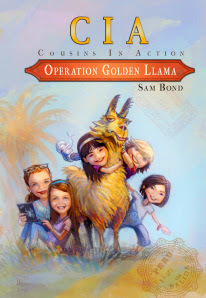 The Cousins in Action Series by Sam Bond begins with Operation Golden LlamaDumped at their eccentric Grandma’s, Cagney, Olivia, Aidan, Lissy and Tess are convinced they’re in for a boring summer. But when Grandma gets a series of mysterious phone calls, and a highly unlikely pet sitter arrives, the cousins find themselves jetting off to Peru, where much to their surprise they find their adventures have only just begun.
The Cousins in Action Series by Sam Bond begins with Operation Golden LlamaDumped at their eccentric Grandma’s, Cagney, Olivia, Aidan, Lissy and Tess are convinced they’re in for a boring summer. But when Grandma gets a series of mysterious phone calls, and a highly unlikely pet sitter arrives, the cousins find themselves jetting off to Peru, where much to their surprise they find their adventures have only just begun.You'll want the sequels, Operation Tiger Paw, Operation Jewel Thief, Operation Pharaoh’s Curse, and Operation Dude Ranch!
Visit Sam Bond’s website or her Amazon page.
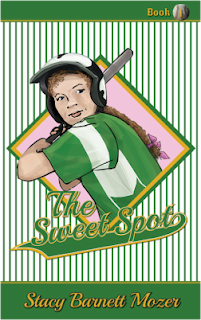 The Sweet Spot, by Stacy Barnett MozerWhen thirteen-year-old Sam Barrette’s baseball coach tells her that her attitude’s holding her back, she wants to hit him in the head with a line drive. All stakes now rest on Sam’s performance at baseball training camp. Placed at the bottom with the weaker players, she will have to work her way up to A league, not just to show Coach that she can be the best team player possible, but to prove to herself that she can hold a bat with the All-Star boys.
The Sweet Spot, by Stacy Barnett MozerWhen thirteen-year-old Sam Barrette’s baseball coach tells her that her attitude’s holding her back, she wants to hit him in the head with a line drive. All stakes now rest on Sam’s performance at baseball training camp. Placed at the bottom with the weaker players, she will have to work her way up to A league, not just to show Coach that she can be the best team player possible, but to prove to herself that she can hold a bat with the All-Star boys.Don't miss the follow-up novel, The Perfect Trip, a road trip adventure!
Visit Stacy Barnett Mozer’s website or her Amazon page.
Middle Grade Contemporary Fantasy Novels
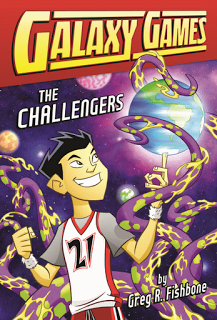 The Galaxy Games Series by Greg Fishbone:
The Challengers
Things are looking up for Tyler Sato (literally!) as he and his friends scan the night sky for a star named for him by his Tokyo cousins in honor of his eleventh birthday. Ordinary stars tend to stay in one place, but Ty’s seems to be streaking directly toward Earth at an alarming rate. Soon the whole world is talking about TY SATO, the doomsday asteroid, and life is turned upside down for Ty Sato, the boy, who would rather be playing hoops in his best friend’s driveway….
The Galaxy Games Series by Greg Fishbone:
The Challengers
Things are looking up for Tyler Sato (literally!) as he and his friends scan the night sky for a star named for him by his Tokyo cousins in honor of his eleventh birthday. Ordinary stars tend to stay in one place, but Ty’s seems to be streaking directly toward Earth at an alarming rate. Soon the whole world is talking about TY SATO, the doomsday asteroid, and life is turned upside down for Ty Sato, the boy, who would rather be playing hoops in his best friend’s driveway….The Amorphous Assassin Thirteen-year-old Tyler Sato has lied, cheated, and scammed his way into the Galaxy Games. Now, on the eve of the galaxy-spanning sports tournament, Tyler’s past is catching up…with a vengeance!Earth’s team of international all-stars is at each other’s throats. A shadowy conspiracy is on the move. And a shape-shifting alien assassin has Tyler in his sights.
Can Tyler step up his game to become the leader Earth needs? Or will the world finally discover that Tyler isn’t quite the hero that everyone believes?
Visit Greg Fishbone’s website or his Amazon page.
The Magic Mayhem Series by D. D. Roy
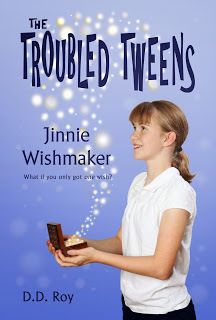 Jinnie Wishmaker
Jinnie WishmakerSix-time USA Today bestselling author Deanna Roy mixes adventure and magic in her first series for middle grade readers. In Jinnie Wishmaker, an eleven-year-old girl discovers she can grant any living thing its one true wish. The trouble is, once she grants the wish, she can’t control the results.
Get the sequels, Marcus Mender and Elektra Chaos.
The Magic Mayhem series begins with Jinnie Wishmaker. However, each book can be read as a standalone book.
Visit Deanna Roy’s blog or the Magic Mayhem Amazon page.
November 27, 2020
Gifts for the writers in your life - or for you! #Holiday #writing guides #amwriting
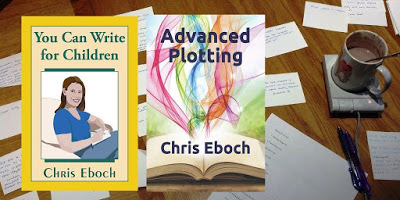 Treat yourself to a writing guide - or get them for your writing friends and family! To send someone an e-book from Amazon, look at the righthand side of the page for the “buy for others” button and they'll get an email to claim your gift, either right away or on a date you choose.
Treat yourself to a writing guide - or get them for your writing friends and family! To send someone an e-book from Amazon, look at the righthand side of the page for the “buy for others” button and they'll get an email to claim your gift, either right away or on a date you choose.You Can Write for Children : How to Write Great Stories, Articles, and Books for Kids and Teenagers
The paperback is $12.99, Kindle is $4.99, or you can read it for free if you have a Kindle Unlimited subscription.
I have two children’s picture books on my computer, and, after reading this book, I know what I need to do to make them better.
 This is a terrific resource book for anyone who has considered writing for children. Each chapter has a tip section as well as specific resources, concrete examples, and easy to understand explanation of terms and topics. Excellent book!
This is a terrific resource book for anyone who has considered writing for children. Each chapter has a tip section as well as specific resources, concrete examples, and easy to understand explanation of terms and topics. Excellent book!A definite “winner” in the “how-to-write” book library.
Grab a copy for aspiring writers you know, or put it on your wish list!
If you know writers who write for either adults or children who need something more advanced, try Advanced Plotting. The paperback is only $9.99, Kindle is $4.99, or you can read it for free if you have a Kindle Unlimited subscription.
 Advanced Plotting is designed for the intermediate and advanced writer: you’ve finished a few manuscripts, read books and articles on writing, taken some classes, attended conferences. But you still struggle with plot, or suspect that your plotting needs work.
Advanced Plotting is designed for the intermediate and advanced writer: you’ve finished a few manuscripts, read books and articles on writing, taken some classes, attended conferences. But you still struggle with plot, or suspect that your plotting needs work. This really is helping me a lot. It’s written beautifully and to-the-point. The essays really help you zero in on your own problems in your manuscript. The Plot Outline Exercise is a great tool!
I just read and—dissected—your well written book: Advanced Plotting. It’s now highlighted in bright orange and littered with many of those little 3M sticky labels. GOOD JOB. There are too many just-for-beginners books out there. Yours was a delight.
Advanced Plotting is helping me to be more focused, to stop and ask the right questions, to dig deeper.
See all of Chris’s books on Amazon or Amazon UK. (For other countries click here.)
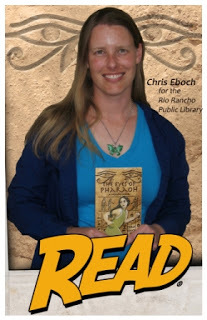 Chris Eboch is the author of over 60 books for children, including nonfiction and fiction, early reader through teen. Her novels for ages nine and up include The Eyes of Pharaoh, a mystery in ancient Egypt; The Well of Sacrifice, a Mayan adventure used in many schools; The Genie’s Gift, a middle eastern fantasy; and the Haunted series, about kids who travel with a ghost hunter TV show, which starts with The Ghost on the Stairs. Chris also writes for adults under the name Kris Bock.
Chris Eboch is the author of over 60 books for children, including nonfiction and fiction, early reader through teen. Her novels for ages nine and up include The Eyes of Pharaoh, a mystery in ancient Egypt; The Well of Sacrifice, a Mayan adventure used in many schools; The Genie’s Gift, a middle eastern fantasy; and the Haunted series, about kids who travel with a ghost hunter TV show, which starts with The Ghost on the Stairs. Chris also writes for adults under the name Kris Bock. Learn more at chriseboch.com.
November 23, 2020
How to Turn an Idea into a Great Story: Making Muscular Action! #writing #amwriting #NaNoWriMo
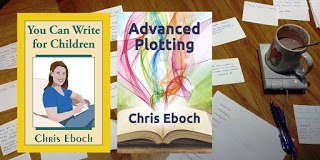 Are you doing National Novel Writing Month (NaNoWriMo)? You may wonder how you can possibly develop your novel enough to get 50,000 words. Here's some help on how to expand a story by increasing the action for a strong middle
Are you doing National Novel Writing Month (NaNoWriMo)? You may wonder how you can possibly develop your novel enough to get 50,000 words. Here's some help on how to expand a story by increasing the action for a strong middle “I love it,” the editor said. “I want to buy it.”
Words every writer wants to hear. But such joy does not come without a price. In this case, the editor followed those lovely phrases with “It needs to be twice as long.”
 But I already had a plot that worked, and a nice fast pace! All in ... uh ... just over 80 pages. So yeah, that was short, even for a children’s novel. And since I was pitching The Ghost on the Stairs as the first in a series, it had to match Aladdin’s series guidelines for ages 9 to 12. So I had to add 70 pages, while keeping the story fast and active.
But I already had a plot that worked, and a nice fast pace! All in ... uh ... just over 80 pages. So yeah, that was short, even for a children’s novel. And since I was pitching The Ghost on the Stairs as the first in a series, it had to match Aladdin’s series guidelines for ages 9 to 12. So I had to add 70 pages, while keeping the story fast and active.Some of you are going, “Yeah, right—I always need to cut, not expand.” That’s a common problem for many, but filling out a story with exciting, dramatic material can cause challenges as well—especially in the middle, where plots can sag and slow. I also see a lot of beginning children’s writers with manuscript in the 5000- to 20,000-word range, a tough sell unless you are doing leveled readers—which often have a very specific word count for each age level. Adult novelists may wind up with novellas, where a full-length novel would have better market opportunities.
So how do you build a bigger manuscript, while keeping it lean and muscular, not padded with fat descriptions or flabby repetition? I studied books on plotting, including Elements of Fiction Writing - Beginnings, Middles & Ends
 (Nancy Kress, Writers Digest Books) and came up with the several literary “protein shakes” to feed my novel.
(Nancy Kress, Writers Digest Books) and came up with the several literary “protein shakes” to feed my novel. Add More PlotIn my Haunted series, siblings Jon and Tania travel with their mother and stepfather’s ghost hunter TV show, and discover Tania can see ghosts. In each book, they have to figure out what’s keeping the ghost here, then try to help her or him move on. In the version of The Ghost on the Stairs I sent to the editor, people already knew the ghost’s name and why she’s stuck here grieving. To expand the manuscript, I made the ghost story more vague. Jon and Tania have to do detective work to discover her name and background.
Exercise: Make a plot outline of your manuscript, with a sentence or two describing what happens in each scene. How easily does your main character solve his problems? Can you make it more difficult, by requiring more steps or adding complications? Can you add complications to your complications, turning small steps into big challenges?
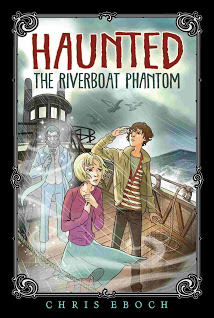 Example: In Haunted Book 2: The Riverboat Phantom, a ghost grabs Jon.
Example: In Haunted Book 2: The Riverboat Phantom, a ghost grabs Jon.I felt the cold first on my arms, like icy vice grips squeezing my biceps. Then waves of cold flowed down to my hands, up to my shoulders, all through my body. I tried to breathe, but my chest felt too tight. My vision blurred, darkened. The last thing I saw was Tania’s horrified face. And I fell.
That’s dramatic enough for a chapter ending. So what’s next? It would be easiest—for Jon and the writer—if Tania is still the only one there when he recovers, and no one else notices his collapse. But if everyone notices, and Jon has to convince his worried mother that he’s not sick, you get complications.
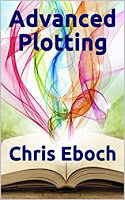
See the "plotting" label to the right for more advice.
Advanced Plotting has tons of advice on building strong plots. Get Advanced Plotting on Amazon in print or e-book.
on Amazon in print or e-book.
You Can Write for Children: How to Write Great Stories, Articles, and Books for Kids and Teenagers is available for the Kindle, in paperback, or in Large Print paperback.
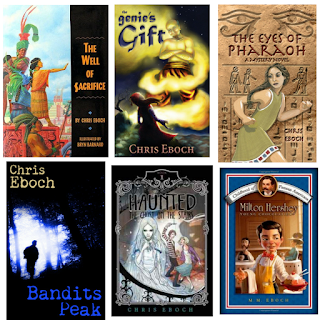
Chris Eboch is the author of over 60 books for children, including nonfiction and fiction, early reader through teen. Her novels for ages nine and up include The Eyes of Pharaoh, a mystery in ancient Egypt; The Well of Sacrifice, a Mayan adventure; The Genie’s Gift, a middle eastern fantasy; and the Haunted series, about kids who travel with a ghost hunter TV show, which starts with The Ghost on the Stairs.

Learn more or read excerpts at www.chriseboch.com or visit her page on Amazon or Amazon UK. (For other countries click here.)
Chris also writes for adults under the name Kris Bock. Her Furrever Friends Sweet Romance series features the employees and customers at a cat café. Watch as they fall in love with each other and shelter cats. Get a free 10,000-word story set in the world of the Furrever Friends cat café when you sign up for the Kris Bock newsletter. Learn more at www.krisbock.com or visit Kris Bock’s Amazon US page or Amazon UK page. (For other countries click here.)
November 16, 2020
You Can Write Strong Stories: The Best Ways to Raise the Stakes for your #NaNoWriMo Novel - #amwriting #Writing
 Get Advanced Plotting from Amazon in print or ebook.Are you doing #NaNoWriMo? You may worry about hitting a slump. What happens next? How can you keep the story going strong? Let’s talk about the stakes – and how to raise them.
Get Advanced Plotting from Amazon in print or ebook.Are you doing #NaNoWriMo? You may worry about hitting a slump. What happens next? How can you keep the story going strong? Let’s talk about the stakes – and how to raise them.Look at your main story problem. What are the stakes? Do you have positive stakes (what the main character will get if he succeeds), negative stakes (what the MC will suffer if he fails), or both? Could the penalty for failure be worse? Your MC should not be able to walk away without penalty. Otherwise the problem was obviously not that important or difficult. The penalty can be anything from personal humiliation to losing the love interest to the destruction of the world – depending on the length of story and audience age – so long as you have set up how important that is for your MC.
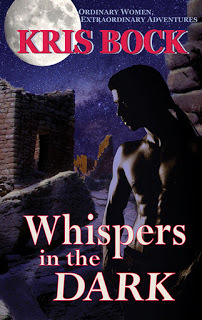 Are things worse at page 200?Note that those complications should also be both Difficult and Important. Say you have a character who needs to get somewhere by a specific time, and you want to increase tension by causing delays. If she simply runs into a series of chatty neighbors, it’s quickly going to get boring (unless you can push it to the point of comedy).
Are things worse at page 200?Note that those complications should also be both Difficult and Important. Say you have a character who needs to get somewhere by a specific time, and you want to increase tension by causing delays. If she simply runs into a series of chatty neighbors, it’s quickly going to get boring (unless you can push it to the point of comedy). Instead, find delays that are dramatic and important to the main character. Her dog slips out of the house while she’s distracted, and she’s worried that he’ll get hit by a car if she doesn’t get him back inside... Her best friend shows up and insists that they talk about something important NOW or she won’t be friends anymore....
Ideally, these complications also relate to the main problem or a subplot. The best friend’s delay will have more impact if it’s tied into a subplot involving tension between the two friends rather than coming out nowhere.
Here’s another important point -- you must keep raising the stakes, making each encounter different and more dramatic. You move the story forward by moving the main character farther back from her goal, according to Jack M. Bickham in his writing instruction book Scene and Structure
 :
: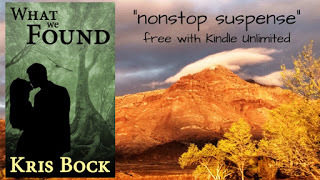 “Well-planned scenes end with disasters that tighten the noose around the lead character’s neck; they make things worse, not better; they eliminate hoped-for avenues of progress; they increase the lead character’s worry, sense of possible failure, and desperation – so that in all these ways the main character in a novel of 400 pages will be in far worse shape by page 200 than he seemed to be at the outset.”
“Well-planned scenes end with disasters that tighten the noose around the lead character’s neck; they make things worse, not better; they eliminate hoped-for avenues of progress; they increase the lead character’s worry, sense of possible failure, and desperation – so that in all these ways the main character in a novel of 400 pages will be in far worse shape by page 200 than he seemed to be at the outset.” If the tension is always high, but at the same height, you still have a flat line. Instead, think of your plot as going in waves. Each scene is a mini-story, building to its own climax -- the peak of the wave. You may have a breather, a calmer moment, after that climax. But each scene should lead to the next, and drive the story forward, so all scenes connect and ultimately drive toward the final story climax.
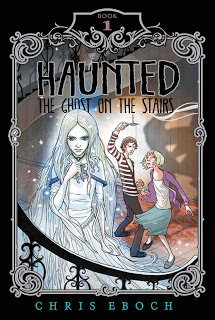 Example: In the Haunted books, the kids have a time limit for helping the ghosts, because their parents’ ghost hunter TV show is only shooting for a few days. But the stakes also rise as the kids get more involved with the ghosts, and understand their tragic plights. Complications come from human meddlers – the fake psychic who wants to take credit, the mean assistant who thinks kids are troublemakers, and Mom, who worries and wants to keep the kids away from anything dangerous.
Example: In the Haunted books, the kids have a time limit for helping the ghosts, because their parents’ ghost hunter TV show is only shooting for a few days. But the stakes also rise as the kids get more involved with the ghosts, and understand their tragic plights. Complications come from human meddlers – the fake psychic who wants to take credit, the mean assistant who thinks kids are troublemakers, and Mom, who worries and wants to keep the kids away from anything dangerous.Exercise: take one of your story ideas. Outline a plot that escalates the problem.

Advanced Plotting has tons of advice on building strong plots. Advanced Plotting is available from Amazon(paperback or Kindle, free in KU) or Barnes & Noble (paperback).
You Can Write for Children : How to Write Great Stories, Articles, and Books for Kids and Teenagers is available for the Kindle, in paperback, or in Large Print paperback.
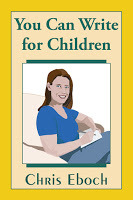 Chris Eboch is the author of over 60 books for children, including nonfiction and fiction, early reader through teen. Her novels for ages nine and up include The Eyes of Pharaoh, a mystery in ancient Egypt; The Well of Sacrifice, a Mayan adventure; The Genie’s Gift, a middle eastern fantasy; and the Haunted series, about kids who travel with a ghost hunter TV show, which starts with The Ghost on the Stairs.
Chris Eboch is the author of over 60 books for children, including nonfiction and fiction, early reader through teen. Her novels for ages nine and up include The Eyes of Pharaoh, a mystery in ancient Egypt; The Well of Sacrifice, a Mayan adventure; The Genie’s Gift, a middle eastern fantasy; and the Haunted series, about kids who travel with a ghost hunter TV show, which starts with The Ghost on the Stairs. Learn more at https://chriseboch.com/or her Amazon page.
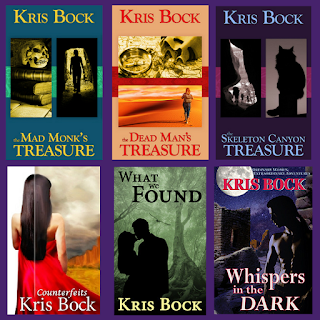 Chris also writes for adults under the name Kris Bock. Kris Bock novels are action-packed romantic adventures set in Southwestern landscapes. Fans of Mary Stewart, Barbara Michaels, and Terry Odell will want to check out Kris Bock’s romantic adventures. “Counterfeits is the kind of romantic suspense novel I have enjoyed since I first read Mary Stewart’s Moonspinners.” 5 Stars – Roberta at Sensuous Reviews blog
Chris also writes for adults under the name Kris Bock. Kris Bock novels are action-packed romantic adventures set in Southwestern landscapes. Fans of Mary Stewart, Barbara Michaels, and Terry Odell will want to check out Kris Bock’s romantic adventures. “Counterfeits is the kind of romantic suspense novel I have enjoyed since I first read Mary Stewart’s Moonspinners.” 5 Stars – Roberta at Sensuous Reviews blogRead excerpts at www.krisbock.comor visit her Amazon page. Sign up for the Kris Bock newsletter for announcements of new books, sales, and more.
October 26, 2020
How to Turn an Idea into a Great Story: Building a Strong Middle #writing #NaNoWriMo #amwriting
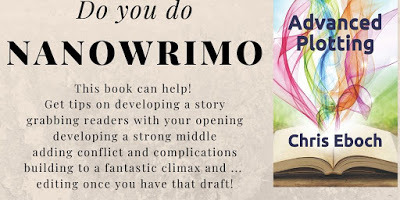 Get Advanced Plotting from Amazon in print or ebook.Are you doing National Novel Writing Month (NaNoWriMo)? Here's some help as you prepare to dive into your story.
Get Advanced Plotting from Amazon in print or ebook.Are you doing National Novel Writing Month (NaNoWriMo)? Here's some help as you prepare to dive into your story.The middle of a story is a trouble spot for many writers. Maybe it feels slow, maybe it feels boring, maybe you can't even figure out what happens next.
A good middle should be filled with complications.
If a character solves his problem or reaches his goal easily, the story is boring. To keep tension high, you need complications. For short stories, try the “rule of three” and have the main character try to solve the problem three times. The first two times, he fails and the situation worsens.
Remember: the situation should worsen. If things stay the same, he still has a problem, but the tension is flat. If his first attempts make things worse, tension rises.
 For novels, you may have even more attempts and failures. In my first Haunted book, The Ghost on the Stairs, I made sure each ghost encounter felt more dangerous. As Tania tries to get closer to the ghost in order to help her, Jon worries that she will go too far and be injured or even killed. With enough variety, you can sustain this kind of tension indefinitely (witness the ongoing battle between Harry and Voldemort in the seven-book Harry Potter series).
For novels, you may have even more attempts and failures. In my first Haunted book, The Ghost on the Stairs, I made sure each ghost encounter felt more dangerous. As Tania tries to get closer to the ghost in order to help her, Jon worries that she will go too far and be injured or even killed. With enough variety, you can sustain this kind of tension indefinitely (witness the ongoing battle between Harry and Voldemort in the seven-book Harry Potter series).Worse and Worser
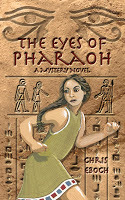 You can worsen the situation in several ways. The main character’s actions could make the challenge more difficult. In my children’s mystery set in ancient Egypt, The Eyes of Pharaoh, a young temple dancer searches for her missing friend. But when she asks questions at the barracks where he was a soldier, she attracts dangerous attention from his enemies.
You can worsen the situation in several ways. The main character’s actions could make the challenge more difficult. In my children’s mystery set in ancient Egypt, The Eyes of Pharaoh, a young temple dancer searches for her missing friend. But when she asks questions at the barracks where he was a soldier, she attracts dangerous attention from his enemies.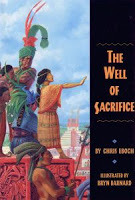 The villain may also raise the stakes. In my Mayan historical drama, The Well of Sacrifice, the main character escapes a power-hungry high priest. He threatens to kill her entire family, forcing her to return to captivity.
The villain may also raise the stakes. In my Mayan historical drama, The Well of Sacrifice, the main character escapes a power-hungry high priest. He threatens to kill her entire family, forcing her to return to captivity.Secondary characters can cause complications, too, even if they are not “bad guys.” In The Ghost on the Stairs, the kids’ mother decides to spend the day with them, forcing them to come up with creative ways to investigate the ghost while under her watchful eyes.
Finally, the main character may simply run out of time. At her first attempt, she had a week. At her second attempt, she had a day. Those two attempts have failed, and now she has only an hour! That creates tension.
• For each turning point in the story, brainstorm 10 things that could happen next. Then pick the one that is the worst or most unexpected, so long as it is still believable for the story.
See the "middles" tab to the right for more advice on building an exciting and dramatic middle.
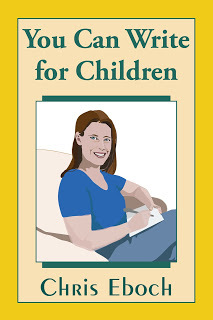 Chris Eboch is the author of over 60 books for children, including nonfiction and fiction, early reader through teen. Her novels for ages nine and up include The Eyes of Pharaoh, a mystery in ancient Egypt; The Well of Sacrifice, a Mayan adventure; The Genie’s Gift, a middle eastern fantasy; and the Haunted series, about kids who travel with a ghost hunter TV show, which starts with The Ghost on the Stairs.
Chris Eboch is the author of over 60 books for children, including nonfiction and fiction, early reader through teen. Her novels for ages nine and up include The Eyes of Pharaoh, a mystery in ancient Egypt; The Well of Sacrifice, a Mayan adventure; The Genie’s Gift, a middle eastern fantasy; and the Haunted series, about kids who travel with a ghost hunter TV show, which starts with The Ghost on the Stairs. Her writing craft books include Advanced Plotting and You Can Write for Children: How to Write Great Stories, Articles, and Books for Kids and Teenagers. You Can Write for Children : How to Write Great Stories, Articles, and Books for Kids and Teenagers is available for the Kindle, in paperback, or in Large Print paperback. Advanced Plotting is available from Amazon(paperback or Kindle, free in KU) or Barnes & Noble (paperback).
Learn more at www.chriseboch.comor her Amazon page.
October 19, 2020
Why You Must Be Cruel to Your Characters - #Writing a Strong Plot - #amwriting for #NaNoWriMo
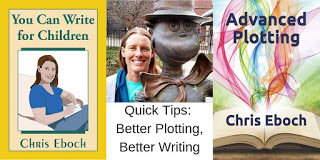 Are you doing National Novel Writing Month (NaNoWriMo)? This challenge is designed to get people moving quickly through a first draft of a novel. Here's some help as you prepare for the challenge.
Are you doing National Novel Writing Month (NaNoWriMo)? This challenge is designed to get people moving quickly through a first draft of a novel. Here's some help as you prepare for the challenge.For a strong plot, you need plenty of dramatic action. (This doesn't necessarily mean fights and car chases. The drama can come from interpersonal relationships or even a person's own thoughts. But dramatic things should happen.) But it's not enough just to have dramatic things happening. It's not just What but also Who.

Your main character needs to be able to overcome the challenge you set for him – but just barely. We don't want to watch superheroes fight weaklings. We want to watch superheroes fight supervillains – or even better, weaklings fight supervillains, and barely win, through courage and ingenuity that overcome the stronger foe.
Conflict comes from the interaction between character and plot. You can create conflict by setting up situations which force a person to confront their fears. If someone is afraid of heights, make them go someplace high. If they're afraid of taking responsibility, force them to be in charge.
You can also create conflict by setting up situations which oppose a person’s desires. If they crave safety, put them in danger. But if they crave danger, keep them out of it.
 In The Well of Sacrifice, Eveningstar never dreams of being a leader or a rebel. But when her family, the government, and even the gods fail to stop the evil high priest, she's forced to act. In the Haunted series, Jon would like to be an ordinary kid and stay out of trouble. But his sister is determined to help ghosts without letting the grown-ups know what she and Jon are doing, and is constantly getting him into trouble. The reluctant hero is a staple of books and movies because it's fun to watch someone forced into a heroic role when they don't want it. (Think of Harrison Ford as Han Solo.)
In The Well of Sacrifice, Eveningstar never dreams of being a leader or a rebel. But when her family, the government, and even the gods fail to stop the evil high priest, she's forced to act. In the Haunted series, Jon would like to be an ordinary kid and stay out of trouble. But his sister is determined to help ghosts without letting the grown-ups know what she and Jon are doing, and is constantly getting him into trouble. The reluctant hero is a staple of books and movies because it's fun to watch someone forced into a heroic role when they don't want it. (Think of Harrison Ford as Han Solo.)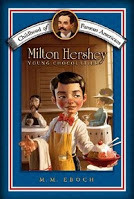 Even with nonfiction, you can create tension by focusing on the challenges that make a person's accomplishments more impressive. In my book Jesse Owens: Young Record Breaker, written under the name M.M. Eboch, I made this incredible athlete’s story more powerful by focusing on all the things he had to overcome – childhood health problems, poverty, a poor education. In Milton Hershey: Young Chocolatier (also written as M.M. Eboch) the story of the man who founded Hershey's chocolate is more dramatic because he started with little business experience, and had an unfortunate habit of trusting his overzealous father.
Even with nonfiction, you can create tension by focusing on the challenges that make a person's accomplishments more impressive. In my book Jesse Owens: Young Record Breaker, written under the name M.M. Eboch, I made this incredible athlete’s story more powerful by focusing on all the things he had to overcome – childhood health problems, poverty, a poor education. In Milton Hershey: Young Chocolatier (also written as M.M. Eboch) the story of the man who founded Hershey's chocolate is more dramatic because he started with little business experience, and had an unfortunate habit of trusting his overzealous father.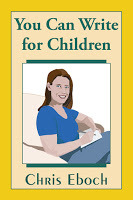 Exercise: Ask yourself these questions. They may lead to new story ideas, or you can use them to further develop characters in your current work.
Exercise: Ask yourself these questions. They may lead to new story ideas, or you can use them to further develop characters in your current work.What are you afraid of?
What's the hardest thing you have had to do or overcome?
What's the hardest thing you've done by choice?
Ask other people the same questions, for more ideas.
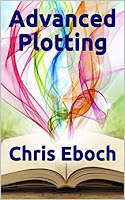 Get You Can Write for Children: How to Write Great Stories, Articles, and Books for Kids and Teenagers for the Kindle, in paperback, or in Large Print paperback.
Get You Can Write for Children: How to Write Great Stories, Articles, and Books for Kids and Teenagers for the Kindle, in paperback, or in Large Print paperback.Advanced Plotting is designed for the intermediate and advanced writer: you’ve finished a few manuscripts, read books and articles on writing, taken some classes, attended conferences. But you still struggle with plot or suspect that your plotting needs work. This book can help.
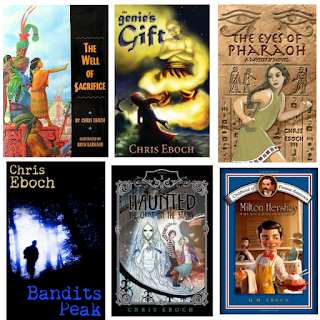
Chris has published over 60 books for children, including nonfiction and fiction, early reader through teen. Her novels for ages nine and up include The Eyes of Pharaoh, a mystery in ancient Egypt; The Well of Sacrifice, a Mayan adventure; The Genie’s Gift, a middle eastern fantasy; and the Haunted series, about kids who travel with a ghost hunter TV show, which starts with The Ghost on the Stairs. Her writing craft books include You Can Write for Children: How to Write Great Stories, Articles, and Books for Kids and Teenagers, and Advanced Plotting.
Learn more at https://chriseboch.com/ or her Amazon page.

Chris also writes for adults under the name Kris Bock. Her Furrever Friends Sweet Romance series features the employees and customers at a cat café. Watch as they fall in love with each other and shelter cats. Get a free 10,000-word story set in the world of the Furrever Friends cat café when you sign up for the Kris Bock newsletter. Learn more at www.krisbock.com or visit Kris Bock’s Amazon US page or Amazon UK page. (For other countries click here.)
October 12, 2020
Two Simple Questions to Turn Your Idea into a Great Story: Setting up Plot Conflict #amwriting #writing #NaNoWriMo
 Are you preparing for National Novel Writing Month (NaNoWriMo)? This challenge is designed to get people moving quickly through a first draft of a novel. Here's some help as you think about your story.
Are you preparing for National Novel Writing Month (NaNoWriMo)? This challenge is designed to get people moving quickly through a first draft of a novel. Here's some help as you think about your story.To develop your story, you'll need conflict. But conflict doesn't just come from dramatic things happening. It comes from the character – what he or she needs and wants, and why he or she can't get it easily.
Start with a premise: a kid has a math test on Monday. Exciting? Not really. But ask two simple questions, and you can add conflict.
 • Why is it important to the character? The stakes should be high. The longer the story or novel, the higher stakes you need to sustain it. A short story character might want to win a contest; a novel character might need to save the world.
• Why is it important to the character? The stakes should be high. The longer the story or novel, the higher stakes you need to sustain it. A short story character might want to win a contest; a novel character might need to save the world.• Why is it difficult for the character? Difficulties can be divided into three general categories, traditionally called man versus man, man versus nature, and man versus himself. You can even have a combination of these. For example, someone may be trying to spy on some bank robbers (man versus man) during a dangerous storm (man versus nature) when he is afraid of lightning (man versus himself).
 Back to the kid with the math test. Let’s say, if he doesn’t pass, maybe he will fail the class, have to go to summer school, and not get to go to soccer camp, when soccer is what he loves most, and all his friends will be going. That’s why it’s important. Assuming we create a character readers will like, they'll care about the outcome of this test, and root for him to succeed.
Back to the kid with the math test. Let’s say, if he doesn’t pass, maybe he will fail the class, have to go to summer school, and not get to go to soccer camp, when soccer is what he loves most, and all his friends will be going. That’s why it’s important. Assuming we create a character readers will like, they'll care about the outcome of this test, and root for him to succeed.Our soccer lover could have lots of challenges—he forgot his study book, he’s expected to baby-sit his distracting little sister, a storm knocked out the power, he has ADHD, or he suffers test anxiety. But ideally we would relate the difficulty to the reason it's important. So let's say he has a big soccer game Sunday afternoon, and is getting pressure from his coach and teammates to practice rather than study for his test. Plus, of course, he'd rather play soccer anyway.
We now have a situation full of potential tension. Let the character struggle enough before he succeeds (or fails and learns a lesson), and you’ll have a story. And if these two questions can pump up a dull premise, just think what they can do with an exciting one!
Come back next time for more tips on linking your conflict to your character.
Do you need help analyzing a plot? Download The Plot Outline Exercise from Advanced Plotting in a form you can edit and reuse!
 Chris Eboch is the author of over 60 books for children, including nonfiction and fiction, early reader through teen. Her novels for ages nine and up include The Eyes of Pharaoh, a mystery in ancient Egypt; The Well of Sacrifice, a Mayan adventure; The Genie’s Gift, a middle eastern fantasy; and the Haunted series, about kids who travel with a ghost hunter TV show. Learn more or read excerpts at www.chriseboch.com or visit her page on Amazon or Amazon UK. (For other countries click here.)
Chris Eboch is the author of over 60 books for children, including nonfiction and fiction, early reader through teen. Her novels for ages nine and up include The Eyes of Pharaoh, a mystery in ancient Egypt; The Well of Sacrifice, a Mayan adventure; The Genie’s Gift, a middle eastern fantasy; and the Haunted series, about kids who travel with a ghost hunter TV show. Learn more or read excerpts at www.chriseboch.com or visit her page on Amazon or Amazon UK. (For other countries click here.)

Chris also writes for adults under the name Kris Bock. Her Furrever Friends Sweet Romance series features the employees and customers at a cat café. Watch as they fall in love with each other and shelter cats. Get a free 10,000-word story set in the world of the Furrever Friends cat café when you sign up for the Kris Bock newsletter. Learn more at www.krisbock.com or visit Kris Bock’s Amazon US page or Amazon UK page. (For other countries click here.)
October 5, 2020
“What do I do with my idea?” How to Turn Inspiration into a Great Story: #amwriting #writing #NaNoWriMo
 National Novel Writing Month (NaNoWriMo) is a challenge designed to get people moving quickly through a first draft of a novel. Prep for November by starting with the NaNo Prep 101 or read on!
National Novel Writing Month (NaNoWriMo) is a challenge designed to get people moving quickly through a first draft of a novel. Prep for November by starting with the NaNo Prep 101 or read on!People often ask writers, “Where do you find your ideas?” But for a writer, the more important question is, “What do I do with my idea?”
If you have a “great idea,” but can’t seem to go anywhere with it, you probably have a premise rather than a complete story plan. A story has four main parts: situation, complications, climax, and resolution. You need all of them to make your story work.
The situation should involve an interesting main character with a challenging problem or goal. Even this takes development. Maybe you have a great challenge, but aren’t sure why a character would have that goal. Or maybe your situation is interesting, but doesn’t actually involve a problem.
 For example, I wanted to write about a brother and sister who travel with a ghost hunter TV show. The girl can see ghosts, but the boy can’t. That gave me the characters and situation, but no problem or goal. Goals come from need or desire. What did they want that could sustain a series?
For example, I wanted to write about a brother and sister who travel with a ghost hunter TV show. The girl can see ghosts, but the boy can’t. That gave me the characters and situation, but no problem or goal. Goals come from need or desire. What did they want that could sustain a series?Tania feels sorry for the ghosts and wants to help them, while keeping her gift a secret from everyone but her brother. Jon wants to help and protect his sister, but sometimes feels overwhelmed by the responsibility. Now we have characters with problems and goals. The story is off to a good start.
• Make sure your idea is specific and narrow. Focus on an individual person and situation, not a universal concept. For example, don’t try to write about “racism.” Instead, write about one character facing racism in a particular situation.
• Ask why the goal is important to the character. The longer the story, the higher stakes needed to sustain it. A short story character might want to win a contest; a novel character might need to save the world.
• Ask why this goal is difficult. Difficulties fall into categories traditionally called man versus man, man versus nature, and man versus himself. You can even combine these. Your character may hunt bank robbers (person versus person) during a dangerous storm (person versus nature) when he is afraid of lightning (person versus himself).
• Even if your main problem is external, give the character an internal flaw that contributes to the difficulty. This adds complications and also makes your character seem more real. For some internal flaws, see the seven deadly sins: lust, gluttony, greed, sloth, wrath, envy, and pride.
• Test the idea. Change the character’s age, gender, or looks. Change the point of view, setting, external conflict, internal conflict. Choose the combination that has the most dramatic potential.
Next time: Building the middle of your story.
 For more help on developing your stories, check out these titles:
For more help on developing your stories, check out these titles: You Can Write for Children: How to Write Great Stories, Articles, and Books for Kids and Teenagers is available for the Kindle, in paperback, or in Large Print paperback.
Advanced Plotting is designed for the intermediate and advanced writer: you’ve finished a few manuscripts, read books and articles on writing, taken some classes, attended conferences. But you still struggle with plot or suspect that your plotting needs work. This book can help.
 Chris Eboch is the author of over 60 books for children, including nonfiction and fiction, early reader through teen. Her novels for ages nine and up include The Eyes of Pharaoh, a mystery in ancient Egypt; The Well of Sacrifice, a Mayan adventure; The Genie’s Gift, a middle eastern fantasy; and the Haunted series, about kids who travel with a ghost hunter TV show, which starts with The Ghost on the Stairs. Her writing craft books include You Can Write for Children: How to Write Great Stories, Articles, and Books for Kids and Teenagers, and Advanced Plotting.
Chris Eboch is the author of over 60 books for children, including nonfiction and fiction, early reader through teen. Her novels for ages nine and up include The Eyes of Pharaoh, a mystery in ancient Egypt; The Well of Sacrifice, a Mayan adventure; The Genie’s Gift, a middle eastern fantasy; and the Haunted series, about kids who travel with a ghost hunter TV show, which starts with The Ghost on the Stairs. Her writing craft books include You Can Write for Children: How to Write Great Stories, Articles, and Books for Kids and Teenagers, and Advanced Plotting. Learn more or read excerpts at www.chriseboch.com or visit her page on Amazon or Amazon UK. (For other countries click here.)
September 28, 2020
You Can Write Great #KidLit for Children: #99cents sale ends soon #amwriting #writing
Get it from Amazon US or Amazon UK.
Remember the magic of bedtime stories? When you write for children, you have the most appreciative audience in the world. But to reach that audience, you need to write fresh, dynamic stories, whether you’re writing rhymed picture books, middle grade mysteries, edgy teen novels, nonfiction, or something else. This book will show you how.
In this book, you will learn:
How to explore the wide variety of age ranges, genres, and styles in writing stories, articles and books for young people.How to find ideas.How to develop an idea into a story, article, or book.The basics of character development, plot, setting, and theme – and some advanced elements.How to use point of view, dialogue, and thoughts.How to edit your work and get critiques.Where to learn more on various subjects. Whether you’re just starting out or have some experience, this book will make you a better writer – and encourage you to have fun!
Whether you’re just starting out or have some experience, this book will make you a better writer – and encourage you to have fun!Grab the book on sale now!
You Can Write for Children: How to Write Great Stories, Articles, and Books for Kids and Teenagers is also available in paperback, or in Large Print paperback.
 Chris Eboch is the author of over 60 books for children, including nonfiction and fiction, early reader through teen. Her novels for ages nine and up include The Eyes of Pharaoh, a mystery in ancient Egypt; The Well of Sacrifice, a Mayan adventure; The Genie’s Gift, a middle eastern fantasy; and the Haunted series, about kids who travel with a ghost hunter TV show, which starts with The Ghost on the Stairs. Her writing craft books also include Advanced Plotting.
Chris Eboch is the author of over 60 books for children, including nonfiction and fiction, early reader through teen. Her novels for ages nine and up include The Eyes of Pharaoh, a mystery in ancient Egypt; The Well of Sacrifice, a Mayan adventure; The Genie’s Gift, a middle eastern fantasy; and the Haunted series, about kids who travel with a ghost hunter TV show, which starts with The Ghost on the Stairs. Her writing craft books also include Advanced Plotting.Learn more at https://chriseboch.com/ or her Amazon page
September 25, 2020
#AmWriting and Running: 6 #Writing Lessons Learned from Jogging #NWHFD #fitnessday
 In March of 2011 I started jogging. Despite the occasional illness, injury, and ‘I don’t wanna,’ I’m still getting out regularly. On one long and rather tedious solo run, I started making connections between jogging and writing and life. I'm sharing them in honor of National Women's Health and Fitness Week (the last week in September each year). See more links on how to “Stay Well, Stay Safe” from WIC.
In March of 2011 I started jogging. Despite the occasional illness, injury, and ‘I don’t wanna,’ I’m still getting out regularly. On one long and rather tedious solo run, I started making connections between jogging and writing and life. I'm sharing them in honor of National Women's Health and Fitness Week (the last week in September each year). See more links on how to “Stay Well, Stay Safe” from WIC.Get Some Running BuddiesIt helps to have inspiration. I started jogging with a Couch to 5K group that met twice a week. Having the regular schedule kept us on track. The program helped us pace ourselves, starting with short runs and frequent walks, and working up to a 45 minute run. We also had an experienced leader to offer advice.
Several of us continued running together after the program ended. I wouldn’t get out there as often if people weren’t waiting for me. I’d be tempted to stop early, if I didn’t have the encouragement of the group. Hey, peer pressure is powerful! You might as well make it work for you. Plus, it’s more fun to run with other people. (Granted, the pandemic makes this more challenging. Some people are apparently doing virtual social jogs where they chat on a group phone call or Zoom.)
 For writers, it’s important to find the right peer group for your needs. For many, this is a critique group. They may be large or small, meet in person or online, have open or closed membership, get together weekly or monthly or as needed. Finding a group that suits your needs is invaluable.
For writers, it’s important to find the right peer group for your needs. For many, this is a critique group. They may be large or small, meet in person or online, have open or closed membership, get together weekly or monthly or as needed. Finding a group that suits your needs is invaluable.Other writers share goals and deadlines, checking in with a friend daily or weekly to report progress. There’s that peer pressure again! Even a non-writing friend can help hold you accountable. (But choose carefully. You don't need someone pressuring you to finish your novel in six months or run a seven-minute mile.)
Finally, social groups can provide camaraderie and networking. I live in a small town with a science and engineering college; I know far more computer geeks than writers. But by making monthly trips to Albuquerque to attend a writing meeting, I’ve made many friends who understand what I do. I’ve also made connections by teaching workshops and guest speaking for groups like Sisters in Crime.
For those who can’t attend in person (or all of us during the pandemic), online discussion boards, listserves, and online classes offer information and a sense of connection. The New Mexico SCBWI group of children's book writers and illustrators has a weekly online "coffee chat" which has been fantastic for keeping in touch. Another writing friend started inviting people to occasional evening chats – "the folks I would grab at a conference to go out for drinks."
Jog - and Write - for Distance, Not Speed
 It really is about the journey, not how fast you get there. Pace yourself, and enjoy the journey, or you might burn out along the way. If you can see the end, or at least imagine the cheering crowds and free food, it might give you the extra boost you need to keep going. But take time to enjoy the sights, and the experience will be a lot more fun.
It really is about the journey, not how fast you get there. Pace yourself, and enjoy the journey, or you might burn out along the way. If you can see the end, or at least imagine the cheering crowds and free food, it might give you the extra boost you need to keep going. But take time to enjoy the sights, and the experience will be a lot more fun.As a writer, don’t focus so much on the response to your query letters. Sure, celebrate successes, and try to learn from disappointments, but put most of your energy into enjoying the journey. (That works for the rest of life, too.)
But Keep Moving Your Feet (or Fingers)
 A slow pace may get you there, but if you have a long way to go, you might as well do it running. A marathon will take a lot longer at a stroll than at a jog, even a slow jog. Run when you can, walk when you need a rest, but keep moving. That’s the only way to reach the end.
A slow pace may get you there, but if you have a long way to go, you might as well do it running. A marathon will take a lot longer at a stroll than at a jog, even a slow jog. Run when you can, walk when you need a rest, but keep moving. That’s the only way to reach the end.Take the time you need to learn and practice your writing craft. Do as many drafts as you need to polish your novel. Don’t rush, but do keep working. Write a page a day, and you’ll have a complete draft in a year. It may not be perfect, but it will be more than what you started with.
Practice Makes Perfect, or At Least Lessens the PainIf you’re training, you need to get out regularly. Running once a month will just leave you sore and frustrated each time, and you won’t see any progress in your fitness.
It’s the same with writing. Establishing habits and sticking to them will keep your mind fit. Writing several times a week will hone your skills and make it easier to get started next time.
Beware of ShortcutsIf I map out a 5K run, but take every shortcut, that could cut the distance down to 3 ½K. Easier, sure, but that won’t prepare me for running a 10K. It’s the same with life. Whether you’re trying to switch careers, meet the right partner, or finish a novel, some shortcuts may help, but others may do more harm than good.
 I work with a lot of writing students. The beginners want to know if they’ll get published after taking one course. Nobody wants to spend 10 years learning how to write, but you need to do the work in order to earn the reward at the end. If you beg your friend to send your rough draft to her editor, you’ll blow your chance to make the best use of that connection. If you self publish your work before it’s ready, you’ll waste time that could be better spent working on your craft.
I work with a lot of writing students. The beginners want to know if they’ll get published after taking one course. Nobody wants to spend 10 years learning how to write, but you need to do the work in order to earn the reward at the end. If you beg your friend to send your rough draft to her editor, you’ll blow your chance to make the best use of that connection. If you self publish your work before it’s ready, you’ll waste time that could be better spent working on your craft.Sometimes the long, hard path is the only one that gets you where you want to go.
Whether Running or Writing, Push Yourself SometimesWith enough practice, you should get better. When I started jogging, it was a struggle to go for 10 minutes without a break. Six months later, I could make it through 45 minutes without stopping.
 And then I plateaued. Jogging had become comfortable, if not easy. Why cause more pain by trying to go farther or faster?
And then I plateaued. Jogging had become comfortable, if not easy. Why cause more pain by trying to go farther or faster?Because that’s the only way to get better. And most likely, it’s the only way to stay interested. Fortunately, one of my jogging partners was great about coming up with new workouts. We added in some sprints one day, did hills another day. We chose different routes on different terrains. Variety keeps it interesting, which makes it easier to work hard.
With my writing, I find that I get bored if I become too comfortable with something. After publishing a dozen children’s books as Chris Eboch, I wanted a change. I started writing romantic suspense for adults, using the name Kris Bock. This brought new challenges – writing books two or three times as long as what I was used to, exploring romantic subplots, delving deeper into character. I didn’t always get things right the first time, but I became a better writer – and I renewed my interest in writing.
 Are you a writer who runs? Join the Writers Who Run Facebook Group to meet up with like-minded folks and learn about events.
Are you a writer who runs? Join the Writers Who Run Facebook Group to meet up with like-minded folks and learn about events. Kris Bock writes novels of romance, mystery, and suspense. Her
Kris Bock writes novels of romance, mystery, and suspense. Her Kris also writes romantic suspense set in the Southwestern U.S. If you love Mary Stewart or Barbara Michaels, try Kris Bock’s stories of treasure hunting, archaeology, and intrigue in the Southwest. Learn more at www.krisbock.com or visit Kris Bock’s Amazon US page or Amazon UK page. (For other countries click here.)
 Whispers in the Dark features archaeology and intrigue among ancient Southwest ruins. What We Found is a mystery with strong romantic elements about a young woman who finds a murder victim in the woods. In Counterfeits, stolen Rembrandt paintings bring danger to a small New Mexico town. Read excerpts at www.krisbock.com or visit her Amazon page.
Whispers in the Dark features archaeology and intrigue among ancient Southwest ruins. What We Found is a mystery with strong romantic elements about a young woman who finds a murder victim in the woods. In Counterfeits, stolen Rembrandt paintings bring danger to a small New Mexico town. Read excerpts at www.krisbock.com or visit her Amazon page.




